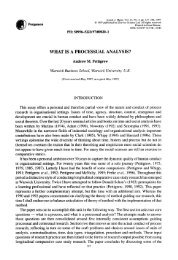Methodological books and papers - Process Research Methods
Methodological books and papers - Process Research Methods
Methodological books and papers - Process Research Methods
You also want an ePaper? Increase the reach of your titles
YUMPU automatically turns print PDFs into web optimized ePapers that Google loves.
<strong>Methods</strong> / Methodology of <strong>Process</strong> <strong>Research</strong>Abbott, A. (1983), Sequences of social events. Historical <strong>Methods</strong>, vol.1,no.4, pp.129.Abbott, A. (1984), Event sequence <strong>and</strong> event duration: colligation <strong>and</strong>measurement. Historical <strong>Methods</strong>, vol.17, pp.192-204.Abbott, A. (1988), Transcending general linear reality. Sociological Theory,vol.6, pp.169-186.Abbott, A. (1990), A primer on sequence methods. Organization Science,vol.1, no.4, pp.375-392.Abbott, A. (1992), From causes to events: notes on narrative positivism.Sociological <strong>Methods</strong> & <strong>Research</strong>, vol.20, pp.428-455.Abbott, A. (1992), What do cases do? Some notes on activity in sociologicalanalysis. In: C.C. Ragin & H.S. Becker (eds.), What Is A case? Exploring theFoundations of Sociological Inquiry. Cambridge: Cambridge University Press,pp.53-82.Abbott, A. (1993), Measure for measure: Abell's narrative method. Journalof Mathematical Sociology, vol.18, pp.203-113.Abbott, A. (1995), Sequence analysis: new methods for old ideas. AnnualReview of Sociology, vol.21, pp.93-113.Abbott, A. (2000), Reply to Levine <strong>and</strong> Wu. Sociological <strong>Methods</strong> &<strong>Research</strong>, vol.29, no.1, pp.65-76.Abbott, A. (2001), Time Matters: On Theory <strong>and</strong> Method. Chicago, IL:University of Chicago Press.Abbott, A. & A. Tsay (2000), Sequence analysis <strong>and</strong> optimal matchingmethods in sociology. Sociological <strong>Methods</strong> & <strong>Research</strong>, vol.29, no.1, pp.3-33.Abell, P. (1987), The Syntax of Social Life: The Theory <strong>and</strong> Method ofComparative Narratives. Oxford: Clarendon Press.Abell, P. (2004), Narrative explanation: an alternative to variable-centeredexplanation? Annual Review of Sociology, vol.30, pp.287-310.
Aminzade, R. (1992), Historical sociology <strong>and</strong> time. Sociological <strong>Methods</strong> &<strong>Research</strong>, vol.20, no.4, pp.456-480.Balogun, J., A.S. Huff & P. Johnson (2003), Three responses to themethodological challenges of studying strategizing. Journal of ManagementStudies, vol.40, no.1, pp.197-224.Barley, S.R. (1990) Images of imagining: notes on doing longitudinalfieldwork. Organization Science, vol.1, no.3, pp.220-247.Barley, S.R. & P.S. Tolbert (1997), Institutionalization <strong>and</strong> structuration:studying the links between action <strong>and</strong> institution. Organization Studies,vol.18, no.1, pp.93-117.Burgelman, R.A. (1985b), Applying the methodology of grounded theorizingin strategic management: recent findings <strong>and</strong> their implications. In: R. Lamb& P. Shrivastava (eds.), Advances in Strategic Management, vol.3.Greenwich, CN: JAI Press, pp.83-99.Büthe, T. (2002), Taking temporality seriously: modeling history <strong>and</strong> the useof narratives as evidence. American Political Science Review, vol.96, no.3,pp.481-493.Chau, V.S. & B.J. Witcher (2005), Longitudinal tracer studies: researchmethodology of the midle range. British Journal of Management, vol.16,pp.343-355.Corsaro, W.A. & D.R. Heise (1990), Event structure models fromethnographic data. In: C. Clogg (edt.), Sociological Methodology.Cambridge, MA: Basil Blackwell, pp.1-57.Dawson, P. (1997), In at the deep end: conducting processual research onorganizational change. Sc<strong>and</strong>inavian Journal of Management. vol.13, no.4,pp.389-405.De Cock, C. & R.J. Sharp (2007), <strong>Process</strong> theory <strong>and</strong> research: exploring thedialectic tension. Sc<strong>and</strong>inavian Journal of Management, vol.23, pp.233-250.DeSanctis, G. & M.S. Poole (1994), Capturing the complexity in advancedtechnology use: adaptive structuration theory. Organization Science, vol.5,no.2, pp.121-147.Dooley, K. (2002), Simulation research methods. In: J. Baum (ed.),Companion to Organizations. Oxford: Basil Blackwell, pp.829-848.
Dooley, K. & S. Corman (2004), Dynamic analysis of news streams:institutional versus environmental effects, Nonlinear Dynamics, Psychology &Life Sciences, vol.8, no.3, pp. 403-428.Dooley, K.J. & A.H. Van de Ven (1999), Explaining complex organizationaldynamics. Organization Science, vol.10, no.3, pp.358-372.Forrest, J. & A. Abbott (1990), The optimal matching method for studyinganthropological sequence data: An introduction <strong>and</strong> reliability analysis.Journal of Quantitative Anthropology, vol.2, pp.151-170.Ferlie, E. & T. McNulty (1997), "Going to market": changing patterns in theorganization <strong>and</strong> character of process research. Sc<strong>and</strong>inavian Journal ofManagement, vol.13, no.4, pp.367-387.Fox-Wolfgramm, S.J. (1997), Towards developing a methodology for doingqualitative research: the dynamic-comparative case study method.Sc<strong>and</strong>inavian Journal of Management, vol.13, no.4, pp.439-455.George, A.L. & A. Bennett (2005), Case Studies <strong>and</strong> Theory Development inthe Social Sciences. Cambridge, MA: MIT Press.Glick, W.H., G.P. Huber, C.C. Miller, D.H. Doty & K.M. Sutcliffe (1990),Studying changes in organizational design <strong>and</strong> effectiveness: retrospectiveevent histories <strong>and</strong> periodic assessments. Organization Science, vol.1, no.3,pp.293-312.Golden, B.R. (1992), The past is the past - or is it? The use of retrospectiveaccounts as indicators of past strategy. Academy of Management Journal,vol.35, no.4, pp.848-860.Golden, B.R. (1997), Further remarks on retrospective accounts inorganizational <strong>and</strong> strategic management research. Academy ofManagement Journal, vol.40, no.5, pp.1243-1252.Gotham, K.F. & W.G. Staples (1996), Narrative analysis <strong>and</strong> the newhistorical sociology. Sociological Quarterly, vol.37, no.3, pp.481-501.Griffin, L.J. (1992), Temporality, events, <strong>and</strong> explanations in historicalsociology: an introduction. Sociological <strong>Research</strong> & <strong>Methods</strong>, vol.20, pp.403-427.
Griffin, L.J. (1995), How is sociology informed by history? Social Forces,vol.73, no.4, pp.1245-1254.Griffin L.J. & R.R. Korstad (1998), Historical inference <strong>and</strong> event-structureanalysis. International Review of Social History, Vol.43, pp.145-165.Hall, P.A. (2006), Systematic process analysis: When <strong>and</strong> how to use it.European Management Review, vol.3, pp.24-31.Heise, D.R. (1989), Modelling event structures. Journal of MathematicalSociology, vol.14, pp.139-169.Hinings, C.R. (1997), Reflections on processual research. Sc<strong>and</strong>inavianJournal of Management, vol.13, no.4, pp.493-503.Huber, G. (1985), Temporal stability <strong>and</strong> response-order biases inparticipants descriptions of organizational decisions. Academy ofManagement Journal, vol.28, no.4, pp.943-950.Langley, A. (1999) Strategies for theorizing from process data. Academy ofManagement Review, vol.24, no.4, pp.691-710.Langley, A (2007), <strong>Process</strong> thinking in strategic organization. StrategicOrganization, vol.5, no.3, pp.271-282.Langley, A., N. Kakabadse & S. Swailes (2007), Longitudinal textualanalysis: an innovative method for analyzing how realized strategies evolve.Qualitative <strong>Research</strong> in Organizations <strong>and</strong> Management: An InternationalJournal, vol. 2, no.2, pp.104-125.Leonard-Barton, D. (1990), A dual methodology for case studies: synergisticuse of a longitudinal single site with replicated multiple sites. OrganizationScience, vol.1, no.3, pp.248-266.Levine, J.H. (2000), But what have you done for us lately? Sociological<strong>Methods</strong> & <strong>Research</strong>, vol.29, no.1, pp.34-40.Mahoney, J. (2004), Comparative-historical methodology. Annual Review ofSociology, vol.30, pp.81-101.McPhee, R.D. (1990), Alternate approaches to integrating longitudinal casestudies. Organization Science, vol.1, no.4, pp.393-405.
Miller, D. & P. Friesen (1982), The longitudinal analysis of organizations: amethodological perspective. Management Science, vol.28, no.9, pp.1013-1034.Mintzberg, H. (1979b), An emerging strategy of direct research.Administrative Science Quarterly, vol.24, pp.582-589.Mitchell, T.R. & L.R. James (2001), Building better theory: time <strong>and</strong> thespecification of when things happen. Academy of Management Review,vol.26, no.4, pp.530-547.Mohr, L.B. (1982), Explaining Organizational Behavior: The Limits <strong>and</strong>Possibilities of Theory <strong>and</strong> <strong>Research</strong>. San Francisco, CA: Jossey-Bass.Monge, P.R. (1990), Theoretical <strong>and</strong> analytical issues in studyingorganizational processes. Organization Science, vol.1, no.4, pp.406-430.Orlikowski, W.J. (2000), Using technology <strong>and</strong> constituting structures: apractice lens for studying technology in organizations. Organization Studies,vol.11, no.4, pp.404-428.Orlikowski, W.J. & J. Yates (1994), Genre repertoire: the structuring ofcommunicative practices in organizations. Administrative Science Quarterly,vol.39, no.4, pp.541-574.Orton, J.D. (1997), From inductive to iterative grounded theory: zipping thegap between process theory <strong>and</strong> process data. Sc<strong>and</strong>inavian Journal ofManagement, vol.13, no.4, pp.419-438.Pentl<strong>and</strong>, B.T. (1995), Grammatical models of organizational process.Organization Science, vol.6, no.5, pp.541-556.Pentl<strong>and</strong>, B.T. & H.H. Reuter (1994), Organizational routines as grammars ofaction. Administrative Science Quarterly, vol.39, no.3, pp.484-510.Pentl<strong>and</strong>, B. (1999), Building process theory with narrative: from descriptionto explanation. Academy of Management Review, vol.24, no.4, pp.711-724.Pentl<strong>and</strong>, B.T. & M.S. Feldman (2007), Narrative networks: Patterns oftechnology <strong>and</strong> organization. Organization Science, vol.18, no.5, pp,781-795.
Pettigrew, A.M. (1985), Contextualist research: a natural way to link theory<strong>and</strong> practice. In: E. Lawler (ed.), Doing <strong>Research</strong> That Is Useful In Theory<strong>and</strong> Practice. San Francisco, Cal.: Jossey-Bass, pp.222-274.Pettigrew, A.M. (1990), Longitudinal field research on change: theory <strong>and</strong>practice. Organizations Science, vol.1, no.3, pp.267-292.Pettigrew, A.M. (1992), The Character <strong>and</strong> Significance of Strategy <strong>Process</strong><strong>Research</strong>. Strategic Management Journal, vol.13, pp.5-16.Pettigrew, A.M. (1997), What is a processual analysis? Sc<strong>and</strong>inavian Journalof Management, vol.13, no.4, pp.337-348.Poole, M.S., A.H. Van de Ven, K. Dooley & M.E. Holmes (2000),Organizational Change <strong>and</strong> Innovation <strong>Process</strong>es. Theory <strong>and</strong> <strong>Methods</strong> for<strong>Research</strong>. New York: Oxford University Press.Quadagno, J. & S.J. Knapp (1992), Have historical sociologists forsakentheory? Thoughts on the history/theory relationship. Sociological <strong>Methods</strong> &<strong>Research</strong>, vol.20, no.4, pp.481-507.Ropo, A., P. Eriksson & J.G. Hunt (1997), Reflections on conductingprocessual research on management <strong>and</strong> organizations. Sc<strong>and</strong>inavianJournal of Management, vol.13, no.4, pp.3312-335.Sminia, H. (2009), <strong>Process</strong> research in strategy formation: theory,methodology, <strong>and</strong> relevance. International Journal of Management Reviews,vol.11, no.1, pp.97-125.Smith, A.D. (2002), From process data to publication: a personalsensemaking. Journal of Management Inquiry, vol.11, no.4, pp.383-406.Tilly, C. (2001), The historical analysis of political processes. In: J. Turner(edt.), H<strong>and</strong>book of Sociological Theory. New York: Springer, pp.567-588.Van de Ven, A.H. (1992), Suggestions for studying strategy process: aresearch note. Strategic Management Journal, vol.13, pp.169-188.Van de Ven, A.M. (2007), Engaged Scholarship: A Guide for Organizational<strong>and</strong> Social <strong>Research</strong>. Oxford: Oxford University Press.Van de Ven, A.H. & Y. Chu (1989), A psychometric assessment of theMinnesota innovation survey. In: A.H. Van de Ven, H.L. Angle & M.S. Poole
(eds.), <strong>Research</strong> on the Management of Innovation. New York: Harper &Row, pp.55-103.Van de Ven, A. & G.P. Huber (1990), Longitudinal field research methods forstudying processes of organizational change. Organization Science, vol.1,no.3, pp.213-219.Van de Ven, A.H. & M.S. Poole (1989), <strong>Methods</strong> for studying innovationprocesses. In: A.H. Van de Ven, H.L. Angle & M.S. Poole (eds.), <strong>Research</strong> onthe Management of Innovation. New York: Harper & Row, pp: 31-54.Van de Ven, A.H. & M.S. Poole (1990), <strong>Methods</strong> for studying innovationdevelopment in the Minnesota Innovation <strong>Research</strong> Program. OrganizationScience, vol.1, no.3, pp.313-335.Van de Ven, A.H. & M.S. Poole (1995), Explaining development <strong>and</strong> changein organizations. Academy of Management Review, vol.20, no.3, pp.510-540.Van de Ven, A.H. & M.S. Poole (2002), Field research methods. In: J.A.C.Baum (ed.), Companion to Organizations. Oxford: Blackwell, pp.867-888.Van de Ven, A.H. & M.S. Poole (2005), Alternative approaches for studyingorganizational change. Organization Studies, vol.26, no.9, pp.1377-1404.Weick, K.E. (1989), Theory construction as disciplined imagination. Academyof Management Review, vol.14, no.4, pp.516-531.Woiceshyn, J. (1997), Literary analysis as a metaphor in processualresearch: a story of technological change. Sc<strong>and</strong>inavian ManagementJournal, vol.13, no.4, pp.457-471.Wu, L.L. (2000), Some comments on "sequence analysis <strong>and</strong> optimalmatching methods in sociology: review <strong>and</strong> prospect. Sociological <strong>Methods</strong> &<strong>Research</strong>, vol.29, no.1, pp.41-64.








